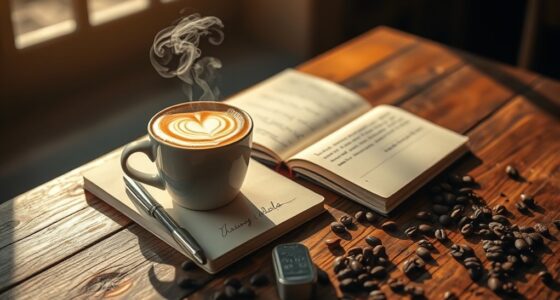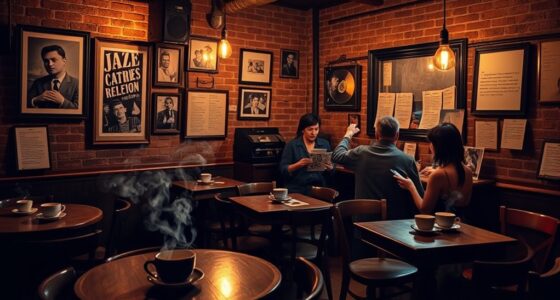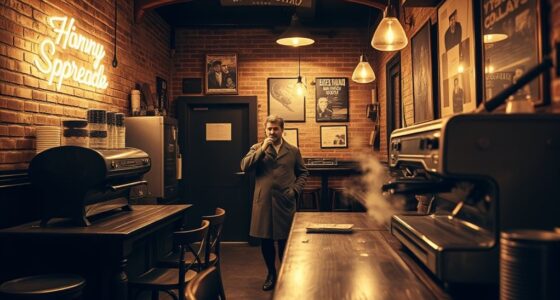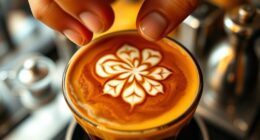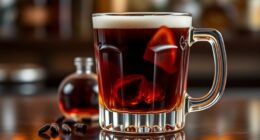Coffee scenes in film often reveal character traits, set moods, and symbolize cultural themes. Think of Jules’ transformation in *Pulp Fiction* or Dale Cooper’s obsession in *Twin Peaks*—these moments turn ordinary routines into memorable cinematic symbols. They help you understand characters’ quirks, emotions, and social bonds while creating atmosphere. If you keep exploring, you’ll discover how filmmakers craft these scenes to leave lasting impressions and deepen storytelling layers.
Key Takeaways
- Iconic coffee scenes reveal character traits and personality shifts, like Jules’ worldview in *Pulp Fiction*.
- Coffee moments establish mood, intimacy, or tension, enhancing emotional depth in film scenes.
- They serve as cultural symbols of routine, comfort, and social connection, enriching storytelling layers.
- Films like *Breakfast at Tiffany’s* and *Twin Peaks* use coffee to evoke atmosphere and character quirks.
- Cinematic use of coffee emphasizes realism, mood, and character quirks, leaving lasting cultural impressions.
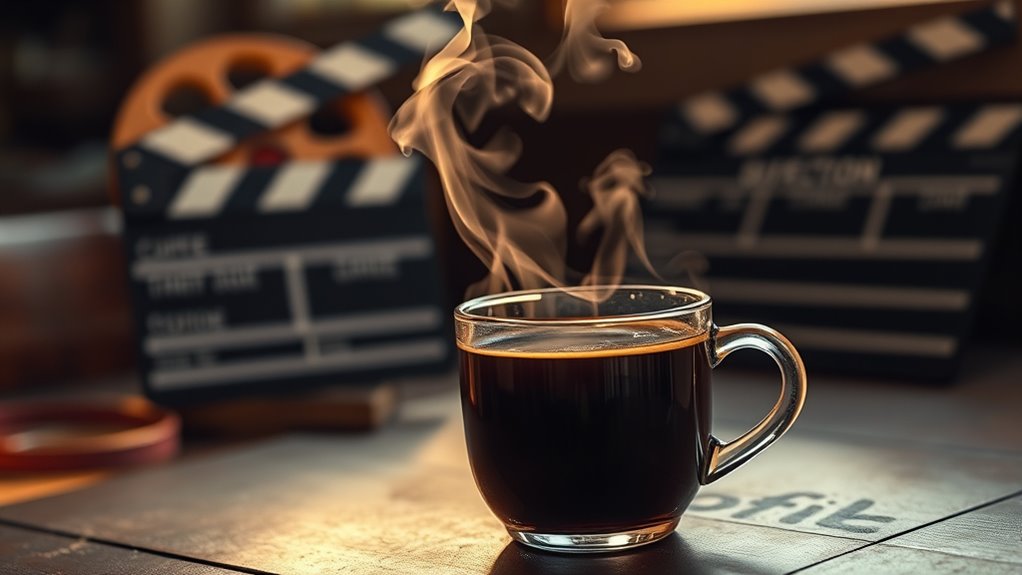
Coffee has long been a staple in film, serving as a powerful tool to reveal character traits, set the mood, or move the story forward. When you watch a movie or TV show, those coffee scenes often stand out as memorable moments that resonate beyond the screen. They become cultural references, instantly recognizable and often quoted, adding layers of meaning to the narrative. These scenes aren’t just about the beverage itself; they’re cinematic devices that deepen character development, establish atmosphere, and enhance storytelling.
Coffee scenes in film reveal character, set mood, and add depth to storytelling.
Whether it’s a tense confrontation over a steaming cup or a quiet moment of reflection, coffee’s presence in film captures a universal experience that audiences relate to. In iconic movies like *Pulp Fiction*, the coffee scene with Jules praising gourmet brews exemplifies how a simple beverage can symbolize more than just comfort. It’s a moment that reveals Jules’ character and his evolving worldview, turning a routine act into a memorable cinematic moment.
Similarly, *Breakfast at Tiffany’s* uses coffee to evoke a sense of intimacy and routine, illustrating the protagonist’s routine life and personal aspirations. In *Twin Peaks*, coffee becomes a signature element of the show’s atmosphere, representing the quirky, mysterious vibe that defines the series. These memorable scenes demonstrate how filmmakers leverage coffee as a storytelling device to evoke emotion and add realism. Additionally, the use of high-quality projectors in creating cinematic environments enhances the visual storytelling of such scenes, making them even more immersive.
Films often depict coffee as more than just a drink; it’s a symbol of comfort, routine, or social connection. Its portrayal spans from humorous and lighthearted moments to intense, dramatic scenes. For instance, a character’s obsession with “damn good coffee,” like Dale Cooper’s in *Twin Peaks*, highlights their personality or state of mind.
Coffee’s versatility as a cinematic device allows it to serve multiple narrative functions—whether to build tension, foster camaraderie, or underline a character’s quirks. Its presence in film and TV shows has become emblematic of everyday life, making scenes involving coffee easily recognizable and culturally significant.
Ultimately, coffee’s role in film isn’t just about the beverage—it’s about what it represents. It’s a storytelling element that can convey comfort, routine, or social dynamics, enriching characters and scenes. Those iconic moments involving coffee leave a lasting impression, reminding you of its power to evoke mood and meaning on screen.
As a cinematic device, coffee continues to be an essential ingredient in crafting memorable, relatable stories that resonate with audiences worldwide.
Frequently Asked Questions
What Movie Has the Venti Coffee Scene?
You’re asking which movie features the Venti coffee scene. In *Role Models* (2008), characters humorously debate coffee size names, including Venti, highlighting café culture’s quirks.
This scene satirizes how confusing coffee sizes have become, especially with Starbucks popularizing Venti. While it’s more of a cultural commentary, it’s the primary film that directly references a Venti coffee moment, making it the key movie associated with this iconic coffee size.
What Movie Has the Coffee Shop Bathroom Scene?
You’re asking about the movie with the coffee shop bathroom scene. In *Pulp Fiction* (1994), Vincent and Mia Wallace share a tense, darkly humorous moment in a coffee shop bathroom.
Quentin Tarantino uses this mundane setting to heighten the scene’s intensity, blending everyday locations with dramatic and comedic elements. This scene stands out as a memorable example of how simple spaces can become pivotal in film storytelling.
Why Don’t They Use Real Coffee in Movies?
You might wonder why movies avoid using real coffee. Studios prefer fake coffee because it won’t stain sets, mess up lighting, or produce strong odors that interfere with filming.
Actors also avoid real coffee to prevent jitters or spills, which can cause multiple takes. Prop coffee made from syrup, tea, or other substitutes stays consistent, is safer, and helps keep scenes clean and visually perfect without the hassle of handling real coffee.
What Is Coffee Scene?
A coffee scene is a key moment in a film where characters gather around coffee, often sharing conversations or moments that reveal their personalities or relationships.
You’ll notice these scenes create intimacy, tension, or humor, making them memorable. They use coffee as a symbol of comfort, connection, or conflict, helping to develop the story and deepen character understanding.
These scenes often become iconic because of their emotional or narrative impact.
Conclusion
As you’ve seen, coffee plays a powerful role in film, symbolizing everything from comfort to rebellion. These iconic scenes remind you how a simple cup can evoke emotion, set the tone, or even spark change. Next time you sip your coffee, think about its cinematic journey and the stories it’s helped tell. Coffee in film isn’t just a beverage—it’s a universal language that connects us all, one memorable scene at a time.


